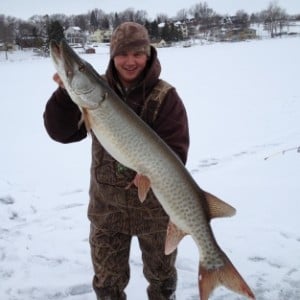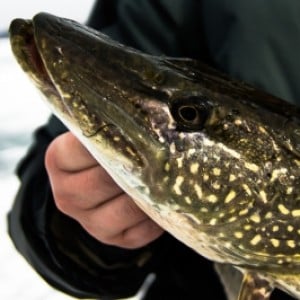Just wondering if there are other fish that have the walleye profile (arches) that show on depth finders. I was marking a ton of fish and threw everything at them and nothing, did snag one big gar. A lot of gar were surfacing in that area of the river 18-22 fow. could the swim bladders just been gar?
IDO » Forums » Fishing Forums » General Discussion Forum » fish arches
fish arches
-
October 17, 2014 at 8:19 am #1464666
The “arch” is not specific to a species but a size.
Sonar reads sound reflection, a larger or more dense object will reflect more sound. Hence panfish are smaller arch and maybe only blue (lowrance color palate) and larger walleyes may be blue outer then red on the inside and if big enough yellow in the middle.So, to answer your question, any fish the size of a walleye will give the same arch profile. And walleyes come in all different sizes…
 kraemofthecrop
Posts: 9October 17, 2014 at 9:01 am #1464687
kraemofthecrop
Posts: 9October 17, 2014 at 9:01 am #1464687It also depends on how fast you are going when you pass over the fish. The faster the speed, the sharper the arch. If you are traveling at a snails pace, fish often look like nice caterpillars on the bottom or anywhere else in the water column. Often times when vertical jigging, i’ll mark fish just off the bottom or really tight to the bottom with no arch present at all. To Mark’s point, the “arch” does not play favorites!
October 17, 2014 at 9:14 am #1464697Your sonar is a cone.
WHether it be your marcum, or 2014 Lowrance.As a fish enters the cone, it is getting closer to the transducer; showing a rise in the sonar; as the fish leaves the cone it is getting further from the transducer; showing a drop in the sonar. Thus the “ARCH”.
The thickness of the arch is correlation to the size of the fish, the length of the arch is correlation to the amount of time it is in the cone.
October 17, 2014 at 11:50 am #1464784I disagree a little bit with what is said above. Yes, I agree on the points given, but different fish give a different reflection of the sonar signal. Suspended/active walleys tend to show up on my 1197 as a rectangle block as oposed to a arc. Smallmouth and carp tend to be larger arcs. Transducer mounting and settings all influence how the reflection or absorbtion of the signal is displayed. Tough to say specifically what is equal in the display
 philtickelsonInactiveMahtomedi, MNPosts: 1678October 17, 2014 at 3:04 pm #1464850
philtickelsonInactiveMahtomedi, MNPosts: 1678October 17, 2014 at 3:04 pm #1464850It really just comes down to some math/geometry. Your transducer sends sound waves down in the shape of a cone, any sort of solidish object(a fish, a sunken tree, random debris, etc) these waves hit will reflect them back up towards your transducer, the time it takes for the sound waves to return are translated into a distance, which will eventually show up on your depth-finder. Why a cone?
Well think of the size of your transducer, if it sent the sound waves straight down, you’d be getting VERY little coverage of the water beneath you, so unless a fish wandered directly underneath your trandsducer, you’d never see anything. Thus a cone is used, pretend the ‘===’ is your transducer, everything in between the pipes || is your transducers coverage, and the ‘–x’s(longer — means longer fish) are fish.
=== | | | | x x | | | | |x| -xIn this situation your fishfinder stinks, it won’t recognize a fish unless it’s directly underneath you. Now let’s look at a cone:
== / \ / \x /x \ / \ / ----x -x\So now we can see that a couple of the fish are going to show up on with our cone-shaped transducer! That explains why transducers use a cone.
So why are they arcs? Well remember that you are shooting sound waves down, which are then reflected back up towards your boat. Consider a long fish directly under your transducer, like the —-x on the bottom row. Let’s look at one more picture, this one will try to show the actual sound waves. So, this time any vertical or sloped line will represent the sound waves, this would be like a zoomed in version of the above picture, only focusing on that bottom fish in the middle.
===== / | \ / | \ / | \ -/-----------\xNow, go back to geometry, the shortest distance from point A(transducer) to point B(fish), a straight line. So, the ‘middle’ of the fish in this example is going to show up as shallower(closer to the boat) than the ‘head’ and the ‘tail’ because the distance from transducer to those parts of the fish are different! The ‘|’ sound wave might register as 15 feet on your depth-finder(this would be the apex of the arc), while the ends of the fish could show up at 17 or even 20 feet or something depending on the size of the fish and the depth.
This would be an example using a BIG fish(like really really big), but generally what happens is you have a fish swimming through your sonar cone(or your boat moves over a stationary fish), which is the same general idea(but harder to show in pictures), so when the fish finds itself centered under your transducer you get the apex of your arch, when it’s on the edge of the cone it is appearing farther away and you get the bottom edges of the arch.
Edit: Uhhhh, code tags aren’t working apparently, my pictures are worthless now :(.
You must be logged in to reply to this topic.